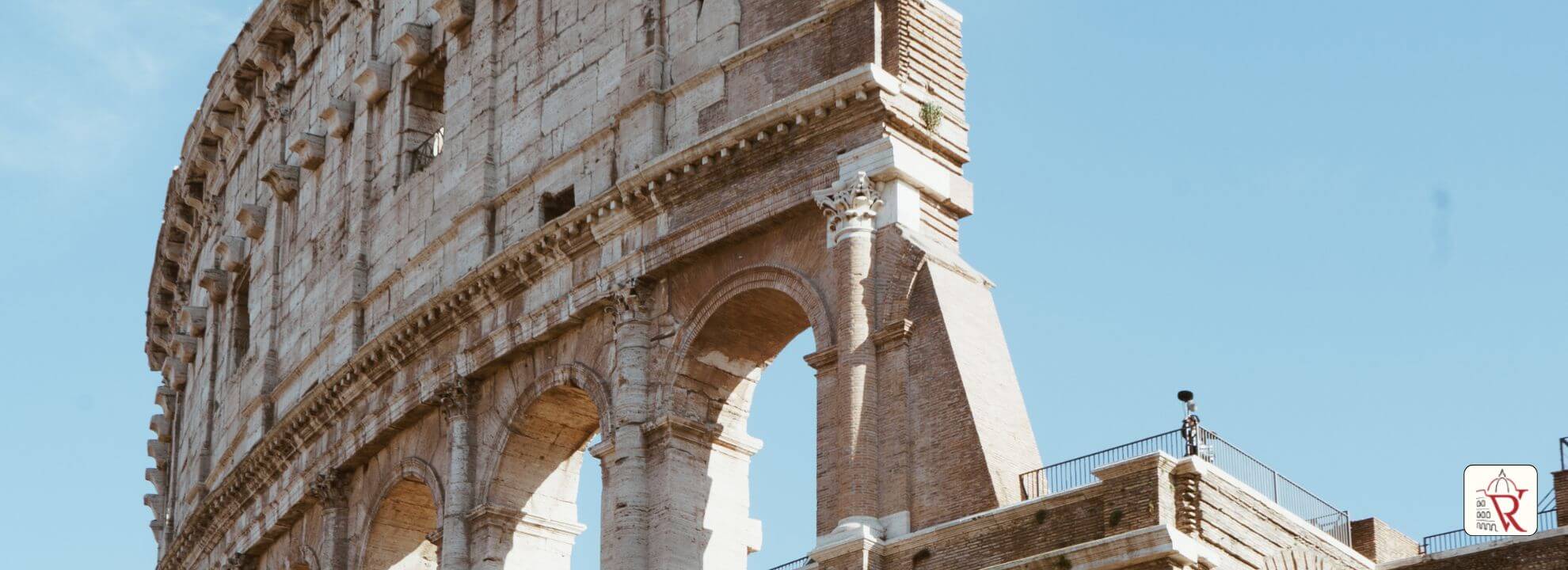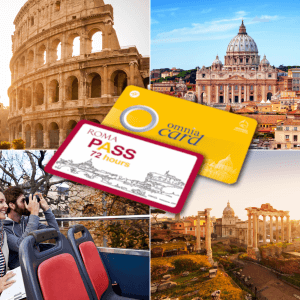10 Colosseum Facts That Will Surprise You
- 7 min read
In this guide you will find all you need to know about Colosseum facts, from the origin of its name and architectural marvels, to surprising historical anecdotes, imperial excesses, and modern cinematic myths. Discover why the Colosseum remains one of the most fascinating monuments in the world.


Omnia card 72h + Roma Pass - Jubilee 2025
1. What are Colosseum facts about its age and construction timeline?
Completed in 80 AD, the Colosseum is nearly two millennia old — an impressive age for any building. However, when compared to other monumental structures of antiquity, it seems almost recent. The Egyptian Pyramids of Giza date back to around 2,500 BC, making them more than twice as old. Likewise, Stonehenge in England, constructed over 5,000 years ago, predates the Roman amphitheater by thousands of years. Despite this, the Colosseum has a unique legacy. Built under Emperor Vespasian and completed by his son Titus, it has remained one of the best-preserved symbols of the Roman Empire. Its relatively “younger” age also explains why many of its original architectural elements and structural features remain visible today, especially after numerous restorations.
2. Why is it called the Colosseum: what did people call it originally?
Today, the term “Colosseum” is instantly recognizable across the globe. However, this wasn’t the name used by ancient Romans. In fact, the structure was originally called the Amphitheatrum Flavium—or Flavian Amphitheater — named after the Flavian dynasty responsible for its construction. The name “Colosseum” is believed to have derived later from a massive bronze statue known as the Colossus of Nero, which once stood nearby. This statue, nearly as tall as a modern-day 12-story building, became a city landmark. Over time, people began referring to the amphitheater by its proximity to the Colossus, and the name stuck, long outliving both the statue and the dynasty that built the monument.
3. Who really knew Julius Caesar’s connection to the Colosseum?
When thinking of the Roman Empire, Julius Caesar often comes to mind. Yet, despite his enormous influence on Roman history, Caesar never witnessed the Colosseum. This may surprise many visitors, as both the man and the monument are closely associated with Rome. In truth, Caesar was assassinated in 44 BC — more than a century before the Colosseum was completed in 80 AD. While Caesar’s political reforms and military campaigns laid much of the groundwork for the imperial system that would follow, the amphitheater was a product of a different era, one focused on public entertainment and imperial spectacle rather than republican ideals.
4. Did any emperors really fight in the Colosseum?
Perhaps the most extreme example of imperial obsession with gladiator games is Emperor Commodus, who ruled from 180 to 192 AD. Fascinated by the thrill and theatricality of combat, Commodus not only attended the spectacles but often took part in them himself. Dressed as a gladiator, he fought wild animals and challenged other combatants in choreographed performances. While these displays were staged to protect him from harm, they were nevertheless controversial. Many in the Roman elite found it unseemly for an emperor to degrade himself in such a manner. However, Commodus saw these performances as a way to connect with the populace — and to glorify his own strength and divine favor. His vanity may have been shocking, but it reveals how central the Colosseum was to Roman imperial identity.

Omnia card 72h + Roma Pass - Jubilee 2025
5. When did gladiator games end at the Colosseum?
For centuries, the Colosseum hosted games that were both brutal and elaborate. Gladiatorial combat was a cornerstone of Roman culture and public life. However, by the 5th century AD, these spectacles had begun to wane. The decline of the Empire meant financial strain, and the immense costs of maintaining the arena and organizing grand-scale events became unsustainable. Moreover, the rise of Christianity brought new values that were increasingly at odds with blood sports. The final recorded gladiator fight took place in 435 AD, though the arena continued to host animal hunts for a few decades thereafter. Eventually, the Colosseum fell into disrepair, and its use as an entertainment venue came to an end.
6. How did earthquakes and reuse affect the structure?
Over the centuries, the Colosseum endured significant damage. Earthquakes, especially the ones in 847 and 1349, caused large sections of the outer walls to collapse. Stones from the damaged structure were then repurposed for other building projects throughout the city, including churches, palaces, and even St. Peter’s Basilica. Despite this, the core of the Colosseum has survived remarkably well. Thanks to restoration efforts beginning in the 19th century and continuing into the 21st, the amphitheater remains not only a tourist attraction but also a symbol of Rome’s resilience and enduring legacy.
7. How was crowd control designed at the Colosseum?
To manage tens of thousands of spectators, the Colosseum was designed with an advanced architectural plan. It had 80 entrances, 76 of which were used by the general public, allowing for rapid and organized entry and exit. The remaining four entrances served special purposes: two were reserved for VIPs such as the emperor and senators, while the other two were used by gladiators. One of these was the “Gate of Life“, through which victorious fighters entered. The other, more ominous, was the “Gate of Death”, used to remove the bodies of those who had fallen in combat. This layout reflected the structured social hierarchy of Roman society, embedded into the very design of the arena.

Omnia card 72h + Roma Pass - Jubilee 2025
8. Colosseum facts: Admission was free for Roman citizens!
Attendance at the games was not only a popular pastime — it was also a political tool. Emperors used the Colosseum to gain favor with the people, providing free entry to Roman citizens as part of a broader strategy of public appeasement. The concept of panem et circenses — bread and circuses — reflected this practice. By entertaining the masses and ensuring they were fed, emperors could maintain social order and prevent unrest. Non-citizens, foreigners, and enslaved individuals might have needed to pay or may have been excluded entirely. Nevertheless, for many Romans, the Colosseum represented a rare opportunity to experience the grandeur of the empire firsthand.
9. What was built on the site before the Colosseum?
Before the Colosseum was built, the site was part of the extravagant Domus Aurea, or Golden House, commissioned by Emperor Nero after the great fire of 64 AD. Central to this imperial complex was an artificial lake, designed to mimic the sea. After Nero’s death, the Flavian emperors sought to erase his legacy and repurpose the land for public use. Accordingly, the lake was drained, and the massive amphitheater was constructed in its place. This transformation from personal luxury to public space was symbolic — it demonstrated a shift in imperial values and reinforced the idea that the emperor served the Roman people.
10. Was Gladiator filmed inside the real Colosseum?
One of the most widely believed Colosseum facts is that Ridley Scott’s epic film Gladiator (2000) was shot on location in Rome. In reality, the production used a combination of special effects and elaborate sets. The actual Colosseum was considered too fragile and protected for large-scale filming. Instead, a partial replica was built in Malta, and many scenes were enhanced with CGI. Despite this, the film’s depiction of the arena helped renew global interest in the site. While not historically perfect, it captured the drama, intensity, and symbolism of the Colosseum in popular culture — proof that its legacy continues to inspire even in modern times.

Omnia card 72h + Roma Pass - Jubilee 2025
🔖 Colosseum facts: save this guide to read during your visit
We recommend saving this article to your phone or printing a copy before your trip. Read it while exploring the Colosseum to unlock these fascinating Colosseum facts in situ — you’ll gain deeper insight into the architecture, history, and hidden stories that make the monument so extraordinary.
👀 Looking for more? Before your visit, don’t miss our Complete Guide to the Colosseum for everything you need to know, and check out our 12 Smart Tips for Visiting the Colosseum to make the most of your experience.

